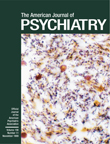Recurrence of Neuroleptic Malignant Syndrome With Olanzapine Treatment
To the Editor: The atypical antipsychotic medication olanzapine, which has a neuroreceptor affinity similar to that of clozapine (1), was not associated until now with the occurrence of neuroleptic malignant syndrome. We report a case in which olanzapine was given to an elderly patient who had suffered two previous episodes of neuroleptic malignant syndrome after treatment with two typical neuroleptics; these again caused neuroleptic malignant syndrome symptoms. To the best of our knowledge, this is the first report of olanzapine-induced neuroleptic malignant syndrome.
Ms. A, a 70-year-old woman with a history of schizoaffective illness, was admitted to our inpatient unit with an acute psychotic-manic episode. Two years and 1 year before this admission, she had been treated for similar episodes with the antipsychotic medications chlorprothixene and then zuclopenthixol HCl; both times this treatment resulted in the symptoms of neuroleptic malignant syndrome. Ms. A had been free of antipsychotic medication for over 6 months. Therefore, treatment with olanzapine, a new atypical antipsychotic medication that was not known to be connected with neuroleptic malignant syndrome, was initiated, 5 mg/day, concurrent with treatment with carbamazepine and betahistine. Because of Ms. A’s extreme restlessness, her dose of olanzapine was increased to 10 mg/day after 2 days. Immediately, a fever of 37.8°C appeared; she had a pulse of 120 bpm and a blood pressure level of 180 mm Hg diastolic and 100 mm Hg systolic. Ms. A’s creatine phosphokinase level was extremely elevated—1,573 U/liter. Ms. A’s parkinsonian symptoms included cogwheel rigidity. Olanzapine treatment was discontinued; Ms. A had a corresponding resolution of her neuroleptic malignant syndrome symptoms over 3 days. Ms. A’s creatine phosphokinase level on the third day was 343 U/liter. Her psychotic symptoms were barely controlled with high doses of benzodiazepines added to her medication regimen.
Neuroleptic malignant syndrome was described in patients who were given the atypical antipsychotics clozapine and risperidone. Recently, Hasan and Buckley (2) reviewed the literature of 19 cases of clozapine-induced neuroleptic malignant syndrome and 13 cases of risperidone-induced neuroleptic malignant syndrome and concluded that these atypical antipsychotics cause neuroleptic malignant syndrome, which resembles classical neuroleptic malignant syndrome. They did not find sufficient evidence for an atypical neuroleptic malignant syndrome with these novel antipsychotics. Three patients with neuroleptic malignant syndrome who were given clozapine (none were given risperidone) had a history of neuroleptic malignant syndrome from typical antipsychotics, as in our case.
Our case demonstrates the occurrence of neuroleptic malignant syndrome after the administration of another atypical antipsychotic medication—olanzapine. Since the symptoms in our case did not include severe body rigidity, further evidence will reveal whether olanzapine-induced neuroleptic malignant syndrome may be classical or atypical neuroleptic malignant syndrome.
1. Bever KA, Perry PJ: Olanzapine: a serotonin-dopamine-receptor antagonist for antipsychotic therapy. Am J Health Syst Pharm 1998; 55:1003–1016Google Scholar
2. Hasan S, Buckley P: Novel antipsychotics and the neuroleptic malignant syndrome: a review and critique. Am J Psychiatry 1998; 155:1113–1116Google Scholar



